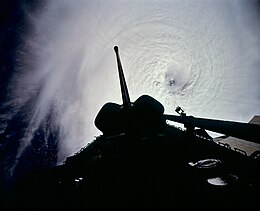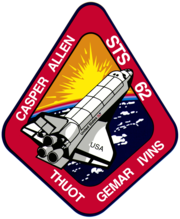STS-62

Columbia passes over Typhoon Owen.
|
|
| Mission type | Microgravity research |
|---|---|
| Operator | NASA |
| COSPAR ID | 1994-015A |
| SATCAT no. | 23025 |
| Mission duration | 13 days, 23 hours, 16 minutes, 41 seconds |
| Distance travelled | 9,366,617 kilometres (5,820,146 mi) |
| Orbits completed | 224 |
| Spacecraft properties | |
| Spacecraft | Space Shuttle Columbia |
| Landing mass | 102,861 kilograms (226,770 lb) |
| Payload mass | 8,759 kilograms (19,310 lb) |
| Crew | |
| Crew size | 5 |
| Members |
John H. Casper Andrew M. Allen Pierre J. Thuot Charles D. Gemar Marsha S. Ivins |
| Start of mission | |
| Launch date | March 4, 1994, 13:53:01 UTC |
| Launch site | Kennedy LC-39B |
| End of mission | |
| Landing date | March 18, 1994, 13:10:42 UTC |
| Landing site | Kennedy SLF Runway 33 |
| Orbital parameters | |
| Reference system | Geocentric |
| Regime | Low Earth |
| Perigee | 296 kilometres (184 mi) |
| Apogee | 309 kilometres (192 mi) |
| Inclination | 39.00 degrees |
| Period | 90.4 minutes |
 Left to right - Standing: Gemar, Ivins, Thuot; Seated: Allen, Casper |
|
STS-62 was a Space Shuttle program mission flown aboard Space Shuttle Columbia. The primary payloads were the USMP-02 microgravity experiments package and the OAST-2 engineering and technology payload, both in the orbiter's cargo bay. The two-week mission also featured a number of biomedical experiments focusing on the effects of long duration spaceflight. The landing was chronicled by the 1994 Discovery Channel special about the Space Shuttle program and served as the show's opening. A C.F. Martin backpacker guitar was also flown aboard Columbia during the mission.
Flight Day One (Friday, March 4) consisted of ascent operations and reconfiguration of the orbiter in order to support orbital operations, an OMS-2 burn to circularize Columbia's orbit to a 160-by-163-nautical-mile (296 by 302 km) orbit, USMP-2 activation, PSE operations, APCG activation, CPCG operations, RMS checkout, DEE operations, CGBA activation. The payload bay doors were opened at 10:26 am EDT.
On Flight Day Two (Saturday, March 5), the astronauts took turns on the crew cabin exercise facility in an effort to slow down the effects of muscle atrophy. Pilot Andrew M. Allen and mission specialist Charles D. Gemar also spent time in the Lower Body Negative Pressure Container. Mission specialists Pierre J. Thuot and Marsha S. Ivins started the Protein Crystal Growth Experiment (PCGE) and the Physiological Systems Experiment (PSE), while scientists on the ground in the Payload Operations Control Center controlled eleven other experiments mounted in the orbiter's payload bay. Mission controllers in Houston also investigated a problem in a fuel line pressure sensor on one of Columbia's three Auxiliary Power Units (APUs). Higher than normal pressures were detected and then returned to normal after engineers powered up heaters on the unit. The APUs provided hydraulic power to operate key landing systems and only one of the three was needed for a successful landing. However, flight rules called for a shortened mission in the event a single unit was lost.
...
Wikipedia

